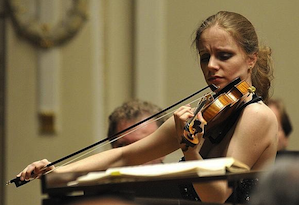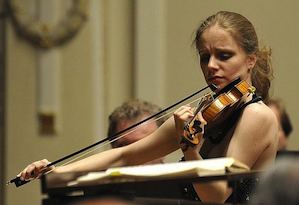
Photo by Ivan Maly
The San Francisco Symphony played a set of farewell concerts last weekend, polishing its tour repertoire before embarking on a trip to London, Paris, Luxembourg, Prague, Vienna, and other European cities.
Opening the program was the “Alcotts” movement from Henry Brant’s 2006 Concord Symphony, an arrangement of Charles Ives’ Concord Sonata, originally for piano and optional viola and flute. The Alcotts were a writing couple who were far ahead of their time in their thinking, espousing veganism, abolition, and women’s rights in the 19th century. The sonata is dedicated to other transcendentalist writers such as Emerson and Thoreau, and has a transcendental sound — abstract in form with pleasantly overlapping ideas. It would have been interesting to hear the other movements. I’m glad the symphony is exporting this American music and philosophy to Europe.
This reading of the Ives achieved a warm and glowing sound. It is essentially a mellow development of Beethoven’s infamous Fifth Symphony motive, with the rhythmic patterns and melodic shape left mostly intact, but stretched out into gentler melodic gestures.
Playing with cool and calculating precision, Julia Fischer dispatched the piece seemingly without much difficulty.
German violinist Julia Fischer was the soloist in Sergei Prokofiev’s Violin Concerto No. 1. Playing with cool and calculating precision, she dispatched the piece seemingly without much difficulty. There was plenty of movement and passion under the surface but it was artfully restrained, and released at select moments. The concerto tends to evaporate into the outer reaches of the sonic stratosphere, and Fischer hit those extremely high notes impeccably in tune. Her concentration power was infectious; the orchestral accompaniment was on point and never overpowering. Fischer played Paganini’s Caprice No. 13 in B-flat Major as an encore — the torrent of difficult chords sounding victoriously resonant.
After intermission, Michael Tilson Thomas led the orchestra in a boisterous performance of Hector Berlioz’ Symphonie Fantastique. The first movement sounded ambitious and energetic, with sudden tender breaks for the lover’s motif. The second movement Waltz was joyous and vibrant, with MTT infusing the orchestra with extra verve in the codetta.
The symphony sounded in tip-top shape for its tour, in which it will also play Mahler’s Third Symphony and John Adams’ recent Absolute Jest with the St. Lawrence String Quartet.
The slow third movement features an on-and-off-stage call and response between two English horns: a pastoral shepherd’s music. The conversation was played with relaxed patience, but the bulk of the movement dragged on; the entire discourse is basically a setup for the return of the searching English horn calls, but this time they are answered only by a chilling timpani rumble: the sound of heartbreak. The ensuing “March to the Gallows” was played with rousing ferocity and felt almost suicidal in its deranged vehemence. The thunderous guillotine chop and the head-plopping-down sound effect sets off the “Dream of a Witches’ Sabbath” led by a mischievous dance in the clarinets, ominously overshadowed by offstage bells tolling and the Dies Irae intoned in the brass.
The symphony sounded in tip-top shape for its tour, in which it will also play Mahler’s Third Symphony and John Adams’ recent Absolute Jest with the St. Lawrence String Quartet. I wish them safe and pleasant travels!

